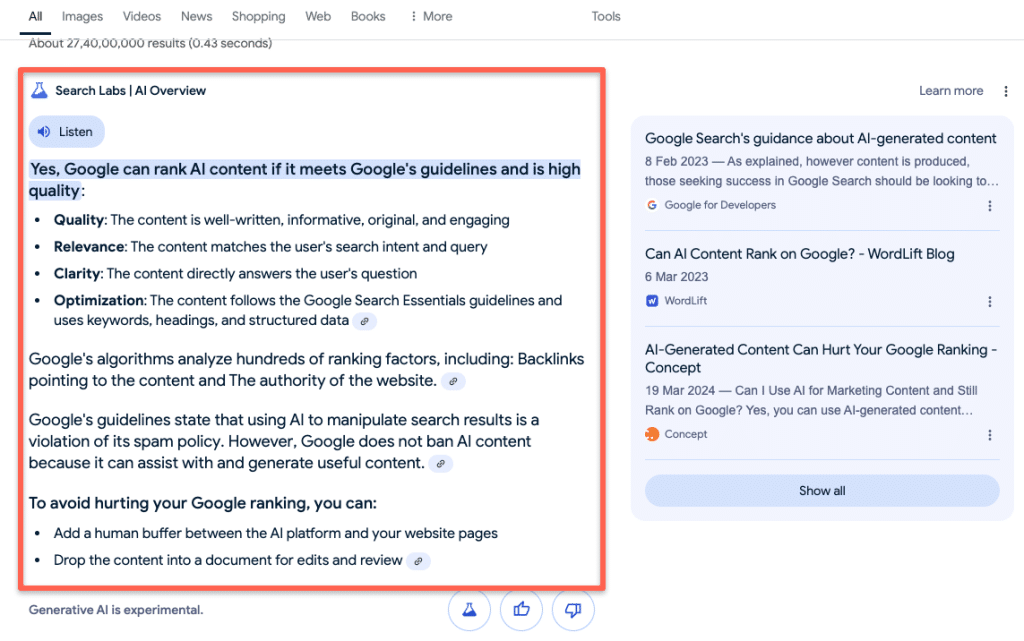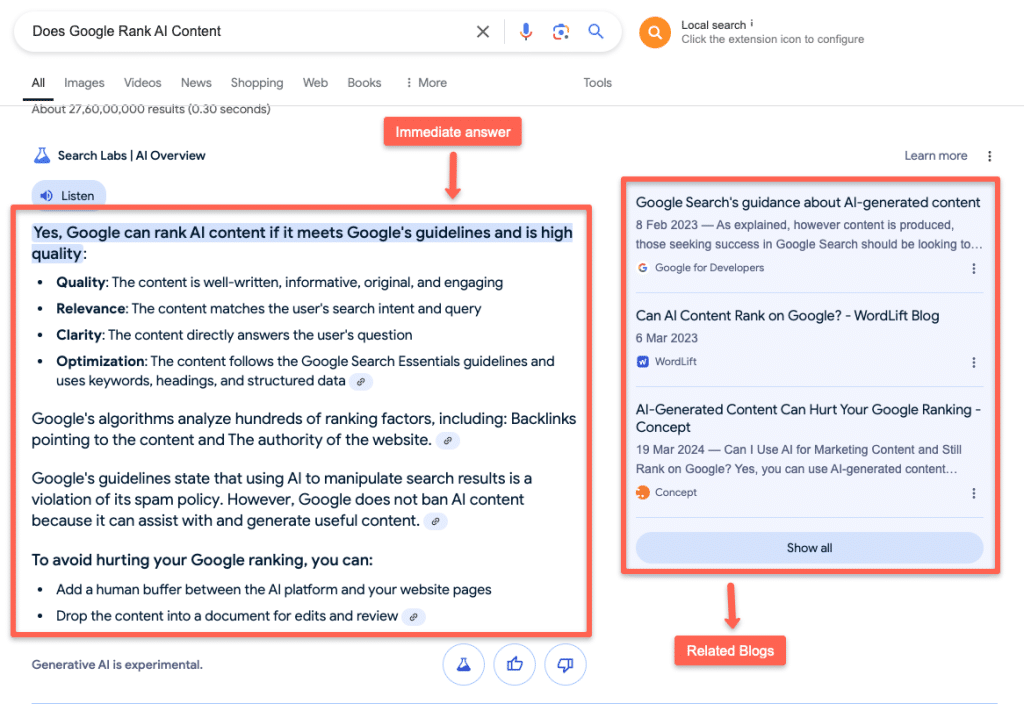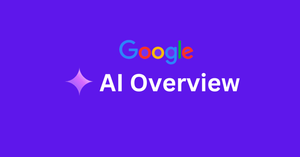Artificial intelligence(AI) is everywhere, and in every field, it is no longer a film related to fiction or tech movies.
But I'm not going to talk about it.
This guide will discuss Google's AI Overview(AIO), which was introduced in May 2024!
In this blog, we look into Google AI Overview, its impact on organic search(SEO), how it works, and more, which will be explored in this guide.
Let's learn it in a simple and easy-to-understand way.
What is Google AI Overview?
Google AI overview(AIO) is an AI-generated answer that will appear at the top of Google based on the user's search query.
It will make the search easier and answer immediately with a source link.

It will answer by analyzing the multiple sources which are available on the web. It uses technologies designed to make the search easier.
AIO is not just focusing on specific keywords, and Google become smarter than before.
Now, it truly understands the user's query based on the question and gives an accurate answer within a few lines.
How Google's AI Overview Impacts Your Website?
Google's search results have changed, and this is why your website's organic traffic is decreasing. Let's look deeper at how it's impacting your website.
1. Reduced Organic Traffic:
When Google introduced its AI overview in the search results, it gave a quick answer at the top of the result page.
So, users will get the answers immediately without clicking on any links or blogs that appear in the SERPs.
For example, I'm searching for 'Does Google Rank AI Content'.
See the image below; it directly answers my query and links to related blogs.

So, the user will not click on the blogs, but few people will visit the websites to learn the in-depth details of their query.
Because of this, websites will see a drop in their visitors or organic search traffic and visibility.
You can adopt these changes and bring traffic to your website, which will be explored in the following sections
2. Change Your SEO Strategies:
The SEO goal is to rank your website at the top of the SERPs so people click on it. You can achieve this through various methods, such as content, keywords, URLs, and more.
But if you want to appear on Google's overview, this strategy won't help, and it is not guaranteed that people will click on your website.
So, you want to change your SEO strategy and adapt it accordingly.
For that, instead of just focusing on keywords, create content with unique insights to be featured in AI overviews.
The content should be more engaging and detailed and also provide value rather than a simple answer. So, add in-depth explanations and examples, write the accurate answer within two lines, and then start to explain it.
Don't just focus on optimizing for search engines. Beyond that, offer in-depth and valuable content. Google will only point to original content and resources.
Structure your content and grow authoritative in your niche, and you can also appear in Google's overview section.
This is the best strategy to get organic traffic with today's Google AI feature.
3. Opportunities for Visibility in AI Overview:
For SEOs, content creators, and website owners, appearing in the Google Overview is challenging. However, you have the opportunity to appear in the AIO.
If you appear in the overview, your website will be considered an authority, and it will increase your credibility in your niche.
How can my content be visible in the AI overview?
Use well-researched content, accurate data with the right source, and proper format.
This means that the content is organized and structured, easy to read, and answers the questions straightforwardly.
Google often features this type of content in the AIO. Also, write content in the question-answer format to match the user queries.
If your content appears in the overview, the audience will see your website as an authority and valuable content and have the chance to click your link, which will appear in the result.
Still, you have the chance to succeed in this AI era. Just adapt, find the balance, provide valuable content, and create unique content unavailable on the web.
How to Adapt Your Strategy for Google's AI Overview?
If you want to be visible in search, adapting is essential. It is about improving user experience and ensuring Google can understand your content easily.
Let's look deeper into it.
Focus on User Intent
It’s no longer enough to use keywords and hope for the best; keywords are also important in SEO.
Beyond that, Google has grown smarter now, and its AI tries to deeply understand a user’s search intent.
For instance, if someone searches for "best AI tools for digital marketing," they might not just want a list.
They might want comparisons, reviews, and recommendations for their specific needs. Your content should go beyond basic-level keywords and aim to give users in-depth details about it.
What do you want to do?
- Create high-quality content that answers the user's questions directly and clearly.
- Think from your audience's perspective. What problems does your audience have? Based on that, write an in-depth and well-researched article or how-to guide that solves their problems.
- Use tools like 'Semrush' or Google's 'People Also Ask' section to understand the users queries.
Structure Your Content for AI
Create content that AI can understand easily! Google AI likes content that is easy to read, understand, and well organized.
But why?
It is easy for Google to pull out the content for featured snippets, which gives the quick answers that appear in the overview.
How can I structure my content better for Google's AI?
- Arrange your content with headings and subheadings. This helps both users and Google's AI understand the structure of your information.
- Use bullet points because lists are easy for Google.
- Summarize your content at the beginning of a post. This will help readers quickly understand the key points and make it easier for Google’s AI to extract relevant information based on the search query.
Improve Your Website Technical Aspects
Improve your website's technical side to make it AI-friendly! Your website performance is also essential for better ranking.
Google wants to provide users with fast, mobile-friendly, organized, and smooth experiences. If your website is slow, difficult to navigate, or looks bad on mobile, Google’s AI hesitates to promote your content in search results.
Make your site load fast. If it is slow, users will not stay on your site long, and Google will not like it.
Also, make your website mobile-friendly because 58.77% of the organic traffic comes from mobile searches.
This is one of the ranking factors in Google.
Use Visual Content
Visual content is more important. Including engaging visuals like images, infographics, and videos can greatly improve your chances of ranking well and having the opportunity to be featured by Google’s AI.
- Use high-quality images that are relevant to the content and add alt text.
- Create videos related to the content and embed them in the content, which will have the ranking potential.
- Use infographics for visualizing the data. Google’s AI can recognize these visuals with the alt text.
For example, if you’re writing a blog post on SEO statistics, an infographic detailing it will engage your audience and increase your chances of appearing in Google's visual search results.
Google AI Overview Statistics
Let's see the best and most important statistics that you should want to know!
According to the SurferSEO study, an AI overview will produce an average of 157 words, and 99% of the answers are under 328.
AI-generated answers in AIO reach 1 billion users monthly and are increasing rapidly.
According to Search Engine Journal, 63% of Google's AI overview appears to be for the healthcare sector, 32% for B2B tech, 23% for e-commerce, 14% for education, 14% for entertainment, 5% for finance, and 18% for insurance.
Challenges for Webiste(SEO)
There are benefits for SEO and websites. Now, let's see its challenges.
Websites are getting less organic traffic because Google now shows direct answers for the searches, right?
Yes, so users get an answer immediately, and only a few people end up clicking the website's links.
Because of this, websites are experiencing a decrease in visitors, which is becoming a problem for website owners and businesses.
So, focus on niche keywords instead of adding broad keywords. Add long-tail question-type keywords, which users search for on search engines.
SEO strategies will change, and we want to adapt accordingly. SEO is not the same as it was a few years ago; it has totally changed.
If you're using old methods, such as repeating the keywords and outdated methods, your content will not appear in the search results.
Because Google is taking more care of user experience by showing helpful and easy-to-find content.
- Write high-quality content that answers the user's question clearly and easily.
- Don't overuse the keyword, or don't just hang on to the keywords. Create content that genuinely helps users.
Conclusion
AI is evolving everywhere, now on Google's search results page.
So, everyone wants to know the user intent and create content based on that, which has a high chance of appearing in Google's AIO.
Adapt to this change and try to show up on the overview. These are the ways Google will work.
I hope you have an idea of how Google AIO works.
If you have any questions, drop them in the comment section.
We are happy to help!

